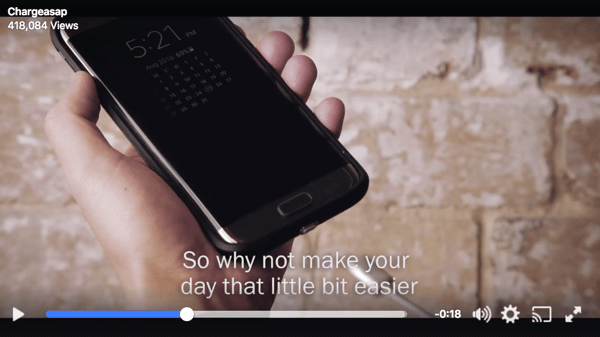 Want to add video to your social media marketing mix?
Want to add video to your social media marketing mix?
Wondering how to get started?
Understanding what types of video work best on each social network will help you create a well-organized video strategy.
In this article, you'll discover four tips for adding video to your social media marketing.

#1: Produce the Right Video for Each Social Platform
Each social network has its own opportunity for video content. Before attempting to post videos on every platform, commit to mastering video on one or two networks first. You can easily incorporate video into your social media content by featuring your business's best content for each platform.
As a social media giant, Facebook is among the essential video platforms. A report found that Facebook users watch approximately 100 million hours of video each day and Facebook has 8 billion daily video views.
When you plan video content for Facebook, understand what Facebook viewers actually enjoy. Captions are essential to Facebook video because most Facebook users watch video without sound. Captions are ideal if someone watches on a crowded train or in a quiet area. Additionally, many viewers will digest content more accurately by reading than hearing.
In 2016, Facebook added automatic captioning to both video ads and videos posted to Facebook pages. Facebook's feature is based on voice-recognition software. You may want to review and edit captions for accuracy. In this video by Chargeasap, the captions reflect the video voiceover word-for-word. The text size and the contrast with the background make the captions easy to read.

Facebook users also enjoy live video. Facebook Live video is watched three times as much as regular video content and continues to gain popularity. Viewers expect live video to be less polished, so you can produce it without a big-budget production team.
Use live broadcasts to keep viewers in the “now” by sharing behind-the-scenes peeks at your events, new product demos, and more. For example, Penn Hongthong prepares her recipes on live video to promote her work as a TV show host, author, speaker, and chef.

Video content on Facebook tends to have a short shelf life if the video doesn't have a viral, shareable appeal. Longer video content typically is a better fit for a network like YouTube.
Get World-Class Marketing Training — All Year Long!
Are you facing doubt, uncertainty, or overwhelm? The Social Media Marketing Society can help.
Each month, you’ll receive training from trusted marketing experts, covering everything from AI to organic social marketing. When you join, you’ll also get immediate access to:
- A library of 100+ marketing trainings
- A community of like-minded marketers
- Monthly online community meetups
- Relevant news and trends updates
On Instagram, you can add video to your story or post video to your feed. With Instagram Stories, you can stream live video or post a 10-second clip. Either way, your video stays on your story for 24 hours. Videos posted to your Instagram feed can be up to 1 minute long.
Because Instagram limits video length, planning for brief videos is important. This emphasis on short videos is different from other social media video networks. On Instagram, make your videos captivating, quick to digest, and direct.
This directness applies to your Instagram captions, too. Ensure your call to action is clear and concise and your captions support the story in your video content, not compete with it. This Nike Training video is a great example of a captivating video with a direct message and helpful captions.
Instagram users share roughly 95 million posts per day and spend an average of 21 minutes a day on the app. What does this mean? People are scrolling through their feeds at a lightning pace. To set up your Instagram videos for success, choose an attention-grabbing thumbnail, like this mustache from Play-Doh.

Twitter's feed moves quickly, making it hard for organic Twitter content to stick. But when Twitter video connects with users, it can spread far and wide.
Twitter recently made live video available in the app, so you don't need to use or download Periscope. This move shows the demand for live video within the native platform and the general need for video content on social channels. In fact, a Twitter report revealed that 82% of users watch video content on the platform.
Because 90% of users view Twitter videos on a mobile device, make your Twitter content mobile-friendly and watchable on the average smartphone, like this video from Philips Hue.
Control lights with your voice, an app, or even your watch! See @tldtoday connect #PhilipsHue to #AppleHomeKit. https://t.co/PyLz5e9Lad pic.twitter.com/OkS6zuDuJw
— Meet hue (@tweethue) January 9, 2017
The same report stated that 70% of users find their videos by simply scrolling through Twitter and 25% are more likely to find content through friends. This means you should create Twitter videos that are engaging and shareable.
Avoid creating in-depth tutorials or videos that only showcase your products. Does your content educate without putting viewers to sleep? When you plan video for your product or service, remember that Twitter users want to discover videos that are entertaining.
YouTube
YouTube is a better place for evergreen content than news or instant video. In fact, YouTube should be the place where your premium video content shines. Although the platform does have live video streaming, at the end of the day, quality execution is more important for YouTube, especially because videos on your channel can be recommended to users watching similar content.
YouTube marketing videos often have high bounce rates because they're too boring or dry. To improve your YouTube marketing, pique curiosity through storytelling. For example, ZenDesk uses simple graphics and a powerful narrative about good relationships to introduce its product.

Discover Proven Marketing Strategies and Tips
Want to go even deeper with your marketing? Check out the Social Media Marketing Podcast! Publishing weekly since 2012, the Social Media Marketing Podcast helps you navigate the constantly changing marketing jungle, with expert interviews from marketing pros.
But don’t let the name fool you. This show is about a lot more than just social media marketing. With over 600 episodes and millions of downloads each year, this show has been a trusted source for marketers for well over a decade.
On YouTube, content needs to keep users engaged until your sales pitch or call to action arises. You don't have to rush with your time limit, but you always have to consider social engagement.
Focus on ways to educate your audience before you start shooting. Rushed and poorly edited videos will drive users to the Back button. However, high-quality video can hold users' attention and drive traffic to your most important pages.
Snapchat
Just like Instagram, Snapchat is all about visual content. To increase video on this platform for your marketing, start by being active and producing plenty of content. Snapchat reports its users watch 10 billion videos per day, and Business Insider reports that active users spend an average of 25-30 minutes a day on the platform.
Tackling Snapchat for marketing isn't quite as simple as other networks. There's little analytical data to track reach of organic posts and no true tools to help you manage your Snapchat presence efficiently. This means if you invest in Snapchat, make sure you have the time and resources to devote to it.
Although Snapchat is known for its filters, developing a branded filter can be expensive, and not all users play with the filters. Instead, you can engage and publish regularly to get users involved.

Snapchat stories play out exactly as that: stories. So don't think about Snapchat in terms of one video or one image. Use your best storytelling ideas to weave ongoing short videos together to promote your brand.
#2: Define Goals for Your Video Content
When you start to craft your video content strategy, you should first know the purpose of video for your brand. Is it aimed at increasing brand awareness? Is there an educational component? Are you going to be heavily promotional or produce newsworthy content?
Before getting started, think about what you want to gain from investing time and resources in creating video content. Some of the most important metrics to consider include:
- Site traffic
- View count (video plays)
- Shares
- Video completion
- Brand awareness
- Lead generation
- Customer retention
After you establish your goals, plan what types of content you'll create to achieve those goals. Don't think about videos as one-off projects. Instead, think through campaigns and themes you'll cover and test over time. No matter what approach you choose, be consistent. For example, Levi's uses GIF videos to promote products.
Packing for sun? Shop for jeans, tees and all the accessories you need. > https://t.co/TF72ODQS2W #LiveInLevis pic.twitter.com/IAslJKI3U3
— Levi's® (@LEVIS) December 30, 2016
Establishing an ongoing video style lets viewers know what to expect from your brand and encourages them to keep coming back. However, if your video approach is all over the place, your audience can easily get confused.
#3: Develop a Consistent Theme or Format
Building on the last tip, it's great to have a social video theme or common message to your content. When you know the purpose of your content and the style you're pursuing, think of a theme you can use to inform your video content.
For example, BuzzFeed's Tasty has redefined the world of recipe content. Their fast and easy-to-digest (no pun intended) videos are educational, drive brand awareness, and focus on shares.

On the other hand, industrial and office supply company 3M uses Instagram to post Boomerang videos to build hype for their upcoming projects. Much of the 3M content goes behind the scenes and shows viewers how certain products are made through short clips.
Creating a theme helps users know what to expect and sets your company's content apart from others. Don't just pick a video theme out of thin air. Instead, analyze the types of videos your audience likes to watch.
You can find this valuable information through your own social analytics for past video content, competitor analysis, or customer surveys. Taking the time to fine-tune your theme will help your video content make a lasting impression.
#4: Invest in the Right Equipment for Your Budget
Most brands wanting to produce social media videos are stuck because of one major reason: cost. Cameras, microphones, lighting, editing equipment, and actors can add up quickly. If you're not careful, video can cannibalize your content-creation funds.
However, you can be money-conscious without sacrificing quality. For starters, try to do as much in-house filming as possible, because production companies can be costly. Check out rental options or even better, use your own devices. This video explains how to set up your own video studio for any budget. Also learn how to create your own lighting setup for about $100.
Here are the essentials of shooting quality video for your company:
- An affordable camera: Cameras on smartphones are just as powerful as some recording equipment. Don't waste your money on a brand-new camera when you have something highly useful in your pocket.
- Simple lighting kit: Great lighting is essential when you're filming video. Try to invest in a standard lighting kit or build your own.
- Quality microphone: If you've seen a low-budget commercial that makes you cringe, it likely had poor lighting and cheap microphones. Purchase a quality mic. Don't use the built-in mic on your smartphone.
- Tripod: Your video needs to be stable and clear. Luckily, several tripods are built to fit your smartphone.
- Editing software: Several affordable or free video-editing software options are available. Smartphone apps like Videoshop and Splice give you essential editing functions.

None of these elements should cost you an arm and leg. Great video is all about knowing what your audience wants and spending the time and effort to produce a strong final product. No one is asking for Scorsese, but paying attention to basic best practices will help you get started on the right foot.
Conclusion
Whether or not video is already part of your social media marketing strategy, expect it to become increasingly important going forward. Video is essential to any social business, and a thoughtful strategy and understanding of best practices will make all the difference in your success.
What do you think? Have you produced video for any social platforms? How did you develop a theme and produce your videos? Please share your thoughts and experiences in the comments.

Attention Agency Owners, Brand Marketers, and Consultants

Introducing the Marketing Agency Show–our newest podcast designed to explore the struggles of agency marketers.
Join show host and agency owner, Brooke Sellas, as she interviews agency marketers and digs deep into their biggest challenges. Explore topics like navigating rough economic times, leveraging AI, service diversification, client acquisition, and much more.
Just pull up your favorite podcast app, search for Marketing Agency Show and start listening. Or click the button below for more information.

